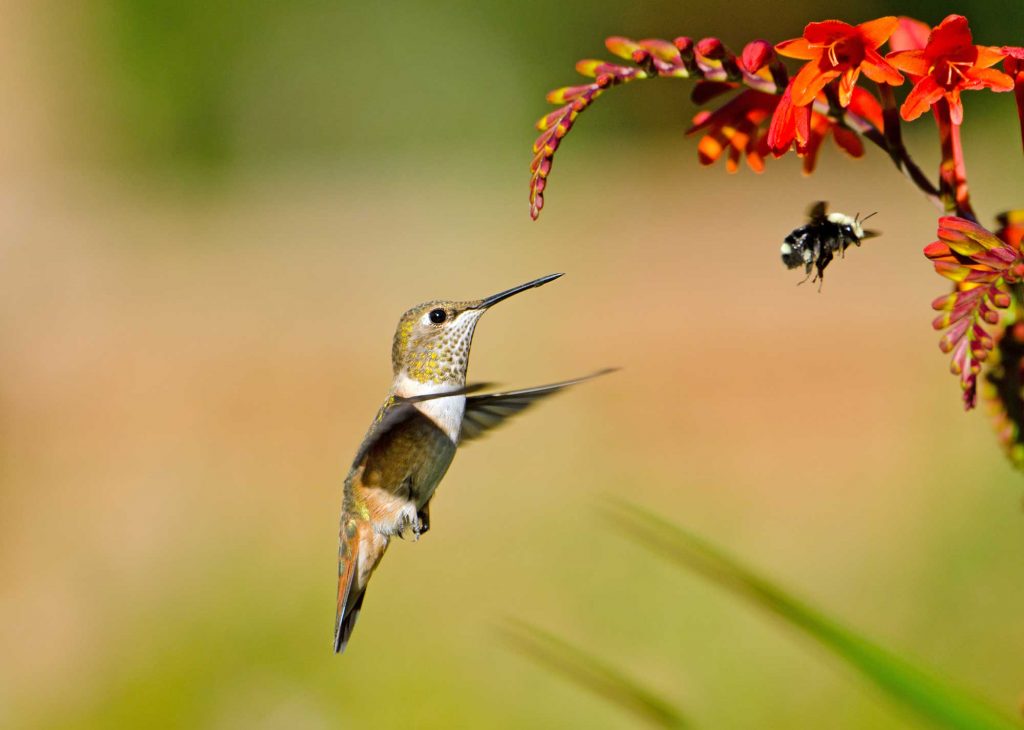Educational Facts About Bees and Other Pollinators

So, just what are pollinators, and do we really need them?
1. If it weren’t for pollinators, we wouldn’t have much of the food we eat.
Did you know that pollinators such as butterflies and bees supply almost one out of 3 bites of food we consume?
If you like pumpkins, blueberries, strawberries, avocados, or honey, you can be grateful to our beautiful pollinators. While we would still have food to eat if our pollinators didn’t perform their duties, our plates would be a lot less flavorful.
About 1/2 of the world’s foodstuffs rely on pollination from insects, especially the work performed by bees. Honey bees independently provide over ten billion U.S. dollars of farming crops in the United States every year. Although some plants are actually wind-pollinated, numerous fruits, nuts and vegetables must rely on our amazing pollinators.
2. What’s the buzz about Bumblebees?!
While pollen is readily available on some flowers and plants, other plants hold the pollen way down in a part of the stamen named anther. Fortunately for us, bumblebees utilize a ploy for getting into it.
Imagine that a bumblebee lands on a flower blossom, as it does, it starts quickly jostling its thorax. When the bumblebee buzzes, the strength of the pulsation ejects the pollen up from the anther. The bee collects the pollen, proud of its work, it moves onto the next lucky flower it finds.
Vast amounts of plants we eat every day are pollinated this way, over 20,000 species to be exact, including tomatoes, blueberries, potatoes, and cranberries, to name a few.
3. Over 70% of fruits and nuts we eat require pollination.
Fruit, seeds and other flowering foods that result from pollination feed almost a quarter of all birds and mammals (including us).
Pollinating insects are vital for food production, and they are also paramount for our ecosystems.
4. Did you know there are many types of Pollinators?
Bees are not the only pollinators around; quite a few animals fall into this category. Birds are common pollinators. When birds carry out pollination, it is called Ornithophily. Hummingbirds, spiderhunters, sunbirds, honeycreepers, and honeyeaters are common birds who pollinate. Mammals, including bats and believe it or not, some rodents, shrews, and even marsupials are used by plants for pollination services. And many insects, including beetles, butterflies and moths are just a few.
Butterflies, similar to bees, scatter pollen when they journey, fleeting from flower to flower, consuming nectar.
5. Not all bees live in hives.
As most people know…Honeybees and bumblebees live in colonies. However, a good number of bees live solitary lives and build nests on the ground.
There are over 20,000 species of bees throughout the world. And at least 4,000 bee species are native to the U.S., including the tiny, solitary Perdita minima, the world’s smallest bee that constructs a miniature nest in sandy desert soil. The kiwi-sized carpenter bee burrows into soft wood to make their nests and lay their eggs. All these species are just as essential pollinators as our typical honey bee!
Of significant mention is the Rusty Patch Bumblebee. The rusty patched bumble bee makes belowground nests in marshes, meadows, and plains. Often using abandoned rodent dens. A regular nest will measure about 16-18 inches below ground, created with soft soil. The Rusty Patch Bumblebee is the first bee to be recorded as an endangered by the U.S. Fish and Wildlife Service in the United States.
6. Our precious Pollinators are quickly vanishing.
Why are these amazing pollinators declining in numbers? Populations are in danger from loss of habitat loss, pesticides, disease, and climate change. Additional study should assist scientists to sufficiently comprehend these threats, determine those species that are most susceptible and focus on preservation steps that are the most beneficial.
7. How can you help our prolific pollinators?
Plant pollinator-friendly plants in your garden such as African basil, butterfly bush, sunflowers and flowering herbs. Put up a hummingbird feeder in your yard and make your backyard bird-friendly. If you find a beehive on your property, make sure to call an eco-friendly, life bee removal professional to save the bees and relocate them to an apiary.
